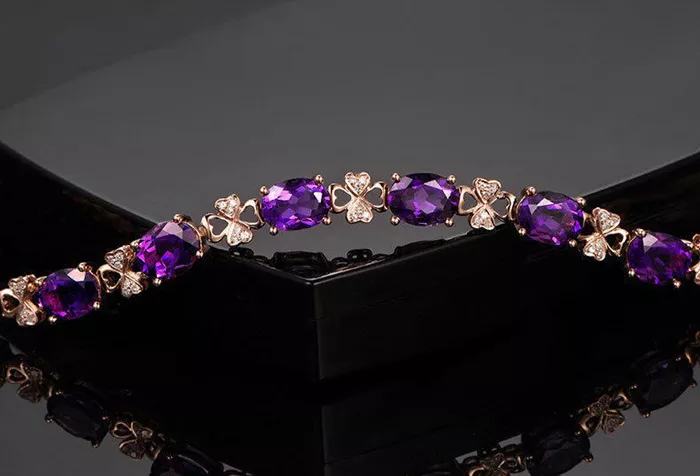Amethyst is one of the most cherished gemstones in the world, often sought after for its vibrant purple hues. It has been admired for centuries, and with its beauty, it’s no surprise that some counterfeit stones have emerged in the market. Whether you’re buying Amethyst jewelry or raw Amethyst, it’s essential to determine its authenticity. In this article, we will explore how to tell if an Amethyst rock is real, covering the important Amethyst properties, testing methods, and practical tips to ensure you’re getting a genuine stone.
Understanding Amethyst: The Basics
Before diving into how to identify a real Amethyst rock, it’s crucial to understand its basic features. Amethyst is a type of quartz, a popular gemstone variety known for its stunning colors ranging from light lavender to deep violet. Amethyst meaning has been tied to various cultures, often associated with calmness and spiritual clarity. Its rich history and symbolism add to its appeal, making it a valuable gem in both jewelry and healing practices.
Amethyst Colors and Varieties
Real Amethyst stones come in a variety of purple shades. The color can range from a soft lilac to a deep, rich purple. The best-quality Amethyst is typically a deep purple with red undertones, though lighter shades can also be genuine. In some cases, Amethyst stones may display a gradient of color, often lighter at the top and darker at the bottom. Fake Amethyst might exhibit inconsistent or unnatural coloring.
Common Methods to Identify Real Amethyst
Knowing how to tell if an Amethyst rock is real involves recognizing several key properties. There are a few tests and characteristics that can help you identify an authentic Amethyst stone, whether it’s in its raw form or made into Amethyst jewelry.
1. The Hardness Test
Amethyst, being a form of quartz, is relatively hard on the Mohs scale. It ranks 7 on the scale, which means it can scratch most substances with a lower hardness. To test the hardness, use a tool such as a steel file or a piece of glass. If the stone gets scratched, it may not be a real Amethyst, as genuine Amethyst should be able to resist scratching.
2. The Glass Test
Since real Amethyst is often cut into fine shapes for Amethyst jewelry, one way to check for authenticity is by tapping the stone lightly against glass. Amethyst is not as hard as glass, so if the stone chips or shows signs of damage, it may be fake. If it resists damage, then it is likely genuine.
3. The Temperature Test
Real Amethyst stones are good at retaining temperature. Hold the stone in your hand for a while, and notice if it warms up quickly. If the stone remains cold for an extended period, it may be a fake. Genuine Amethyst, however, tends to warm up naturally with the heat of your hand.
4. The UV Light Test
Amethyst has a distinct reaction under UV light. When exposed to a blacklight or UV light, real Amethyst typically exhibits a bluish or purplish glow. A fake stone may not show this response or could display an entirely different glow, signaling that it’s not authentic.
Observing Amethyst Properties
Genuine Amethyst stones have distinct physical properties that can help you verify their authenticity. Aside from the color and hardness, you should pay attention to the clarity and cut of the stone. Natural Amethyst crystals often contain small inclusions that give them character. A flawless Amethyst might be a sign of it being synthetic or enhanced.
Amethyst Cut and Clarity
Real Amethyst stones usually have a few visible inclusions, which make each piece unique. These inclusions are often natural and may appear as tiny lines or bubbles inside the stone. Synthetic Amethyst, on the other hand, often lacks these inclusions or may have more polished surfaces that look too perfect. When buying Amethyst jewelry, be cautious of stones that appear too flawless or overly polished, as these could be synthetic or treated to appear better than natural stones.
Understanding the Amethyst Benefits
Apart from its striking beauty, Amethyst also has a number of reputed Amethyst benefits. Many people believe Amethyst promotes mental clarity, emotional balance, and spiritual growth. While these benefits are not scientifically proven, they have contributed to the gemstone’s popularity in metaphysical practices. A genuine Amethyst stone can also be used for meditation, healing, and other spiritual purposes.
Conclusion
Determining whether an Amethyst rock is real involves a few simple but effective tests. Understanding its natural properties, including color, hardness, and clarity, will help you distinguish authentic stones from imitations. When buying Amethyst for its beauty or metaphysical properties, always keep these tests in mind. With careful observation and testing, you can confidently tell if you are purchasing genuine Amethyst jewelry or rocks.
By following the methods outlined above, you’ll be well on your way to identifying a real Amethyst stone. Whether you’re buying Amethyst jewelry or investing in raw stones, knowing how to check for authenticity ensures you get the best quality and value.
Related topic:
- Can Pink Amethyst Be Immersed in Water? A Complete Guide
- Does Amethyst Help You Sleep?
- Does Amethyst Fade in Sunlight?


